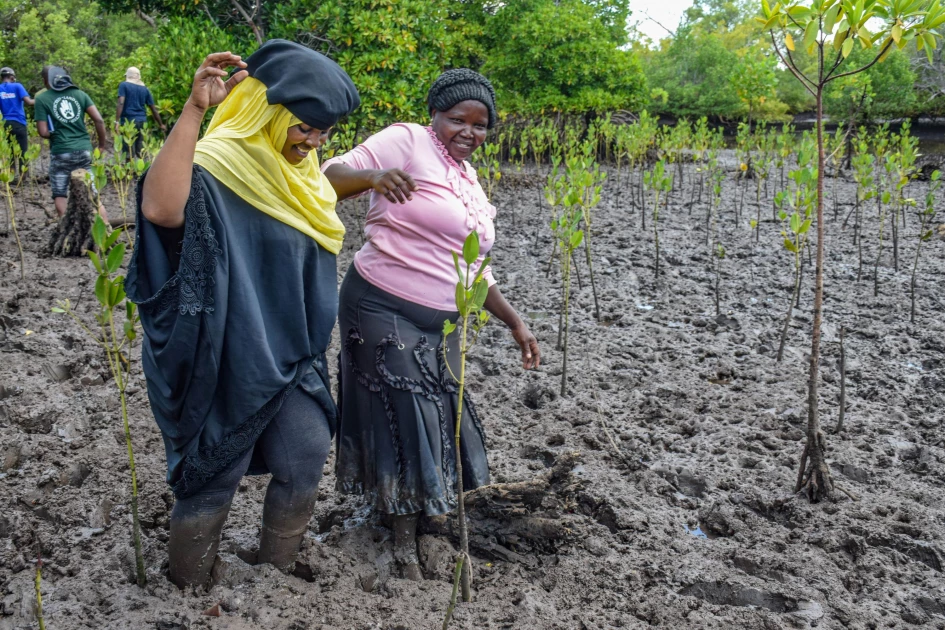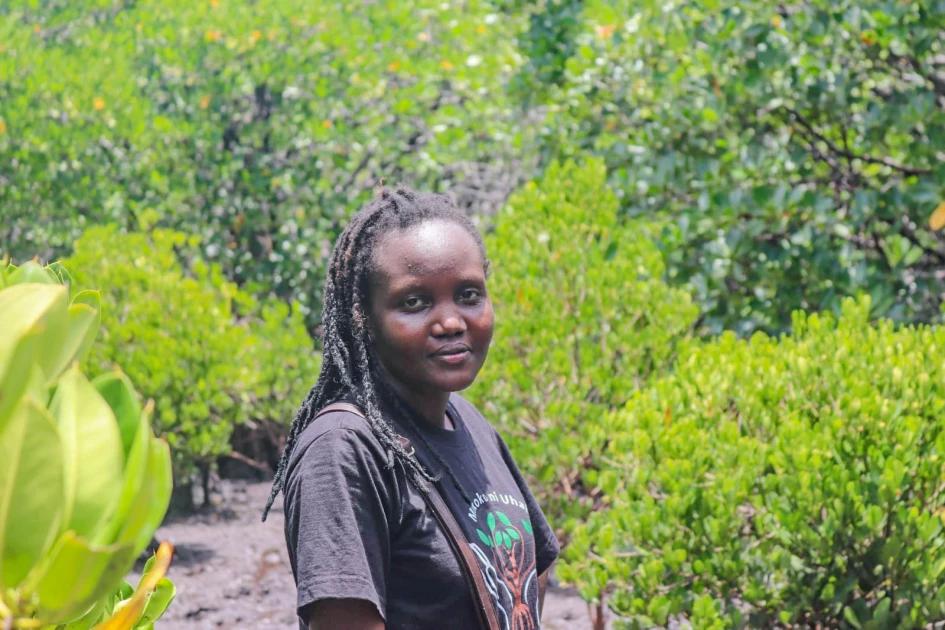Saving Lamu mangroves: from futile photo ops to real progress

Husna Bakari, 26 at the Chukuchu mangrove restoration site on Pate Island in Lamu County. She is the vice-secretary of a youth-led group, Pate Resources and Tourism Initiative (PRATI), that is championing CBEMR mangrove restoration on the island.

Audio By Vocalize
Each year, visitors join locals in ceremonial mangrove planting, taking photos with the seedlings before leaving them to their fate. In so doing, guests have ignored the locals’ indigenous or scientists’ technical knowledge on mangrove restoration.
Regrettably, this approach has not yielded results. Targeted areas for forestation continue to degrade and are now extending far onto dry lands as rising sea levels rage.
The Kitangani mangrove restoration site, where tens of tons of dredged sand were deposited in 2018 and is now a man-made beach, remains a reminder of such efforts, where planning has been done four times, all in futility.
However, a ray of hope shines from a section of the Lamu archipelago’s Pate Island. There, a dedicated, youth-led group, Pate Resources and Tourism Initiative (PRATI), taking stock of the failed ceremonial planting approach, is ditching the photo ops and spearheading a more strategic move for mangrove survival.
To effectively respond to this challenge, a Community-based Ecological Mangrove Restoration (CBEMR) approach is being deployed. This approach, spearheaded by Wetlands International, a non-profit organization, takes into account both the biological and ecological aspects of mangroves. Further, it also seeks first to understand the historical and sociological underpinnings that influence ongoing restoration efforts.
“For our Chukuchu site, we have been taught the importance of assessing the salinity, hydrology, and ecological conditions and getting the right species to transplant, unlike before when we would plant any propagule anywhere,” Husna Bakari, the group’s vice secretary, says as she wades through thigh-high thick mud.
The approach by the community, coupled with indigenous knowledge on mangroves, is demonstrating remarkable results. Ideally, the new tactic mirrors a nature-take-its-course approach, where the right conditions are mimicked. PRATI group members say they have seen a success rate of mangrove transplants growing to the tune of over 97 percent.
For Pate locals who are restoring Chukuchu degraded sites previously destroyed by illegal loggers in search of mangrove roots for use in limestone mining kilns, their long history and cultural connection to the mangroves—in building, fishing, medicine, and fuel—is slowly returning.
“Despite the ban on limestone production several years ago, we still feel the impact here today. This area was cleared, and the mangroves were used in limestone kilns,” says Shawlet Cherono Wetlands International’s project officer stationed in Lamu.
When Citizen Digital visited the Chukuchu restoration site, the degradation was evident. Nevertheless, the steps that have been taken by the group are bearing fruit as the mangrove canopy is slowly returning.
The already degraded site is regaining its former state after years of failed germinations due to a lack of knowledge. Actually, a nursery to complement the efforts is nurtured at the site.
“Sand dredging for development activities has not only caused degradation but has also led to failed reseeding for Kitangani, unlike areas like Chukuchu where regeneration is taking shape.
“Development partners fall short of implementing proper environmental impact assessment protocols,” says Lilian Nyaega, Wetlands International’s Regional Project Officer, adding that water flushing occurs when there is a natural inflow and outlet of both fresh and saline water.
Environmentalists have expressed reservations that failure to have a proper environmental assessment when dredging sand in the Indian Ocean will severely hurt years of mangrove restoration work.
Additionally, seedlings have been erroneously planted on fresh water channels and are flushed into the sea when it rains on the mainland. Further, small mud crabs have been destroying soft-stemmed propagules since crabs use such bare, muddy land as breeding grounds.
1997 El Niño impact
The Mkunumbi restoration site in Lamu West, for example, exemplifies the ongoing struggles to restore mangroves. Twenty-seven years ago, a heavy freshwater influx from neighboring Lake Kenyatta altered the area's salinity, hindering natural regeneration.
The Kiongwe Mjini and River Simba confluence, once a thriving wetland, remains barren, a hallmark of struggles. Nevertheless, the 420-member Mkunumbi Community Forest Association (CFA) is working with the Kenya Forest Service (KFS) to save the area.

Adding to the woes is the recent emergence of a stalk-borer
pest. The invasive insect bores through the mangrove stem and is evidenced in
yellow leaves, jeopardizing restoration. Farich Omar, the 28-year-old
chairperson of Mkunumbi CFA, urges scientists to prioritize finding a solution.
“Scientists have not clearly been able to classify the
borer, and so the disease is a mystery, implying that appropriate mitigation
measures cannot be confirmed yet. I can, however, confirm that the pest is
taking a toll on restoration efforts,” Cherono says.
Already, the Kenya Forest Research Institute (KEFRI) is
investigating the pest, but a definitive cause and mitigation strategy remain
elusive. A KEFRI technical report published last year identifies two possible
culprits: a metarbelid moth and a beetle.
The report also highlights the presence of this pest in other coastal areas like Vanga, Gazi, and Lamu, causing widespread mangrove dieback.
“In Kiunga Marine Park, an unknown insect pest has been
reported to be responsible for the dieback. The infested areas where the undescribed
metarbelid moth is wreaking havoc include Vanga, Gazi, Tudor, Mtwapa, Ngomeni,
and Lamu, and there are reports of specific mangrove species declining due to
the pest,” the paper reads in part.
Mangroves, the salt-tolerant trees and shrubs in the intertidal
regions of the tropical and subtropical coastlines, thrive where freshwater
mixes with seawater, and their root structure is able to eliminate salt,
remaining green throughout.
They grow in five coastal counties of Lamu, Tana River,
Kilifi, Mombasa, and Kwale in tidal estuaries, creeks, and protected bays. The
insects have infested the trees, even as scientists warn that climate change
and rapidly rising sea levels are wiping out these fish-breeding grounds.
Kenya Forest Services (KFS), on its part, is still implementing stricter logging protocols, save for pockets of illegal logging going on within the Lamu archipelago. Lamu County is the only area where mangrove harvesting is permitted, after locals petitioned the government over an initial blanket ban.

Nearly 65 percent of Kenya’s mangroves grow in Lamu County, which also harbors eight of the nine species found in the country, prompting the county leadership to demand forty percent of carbon credit proceeds for locals, if actual stock is established.
Carbon credit stakeholders, including the national government, are still analyzing the carbon stock levels of mangroves in Lamu County, which hosts nearly 65 percent of the total mangrove forest cover in Kenya.
“Interest in carbon credit here is growing. I urge that the locals who have been restoring these mangroves receive an upfront forty percent of the proceeds, and the county is handed a twenty percent share,” Lamu Governor Issa Timamy told this writer in an interview.
Mangroves and seagrass absorb the largest quantities of carbon from the atmosphere and store it, consequently decreasing the effects of global warming. Such habitats are described as carbon sinks and contain large stores of carbon accumulated over hundreds to thousands of years.
Lamu County has the largest stock of mangrove forestry, sitting on 92,200 acres, followed by its neighboring Kilifi County with 21,100 acres. Kwale County and Mombasa have 20,600 acres and 9,300 acres, respectively, while Tana River has eight acres. Lamu County, therefore, is one of the country’s critical carbon sinks.


Leave a Comment